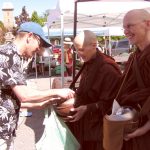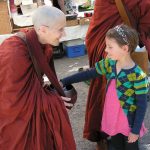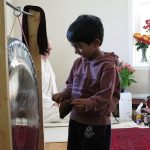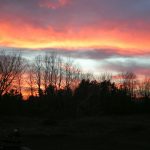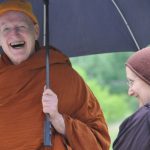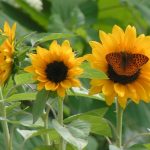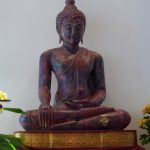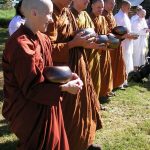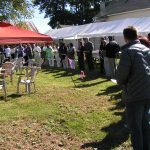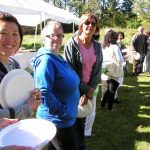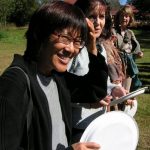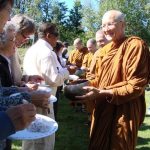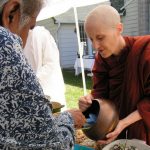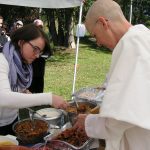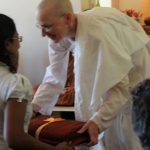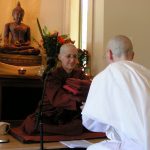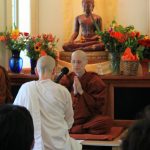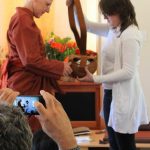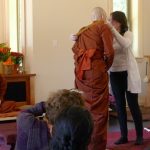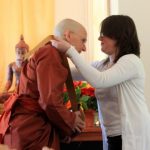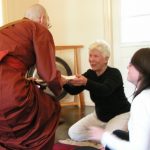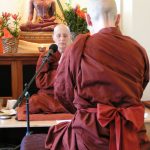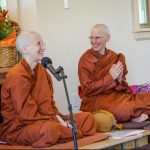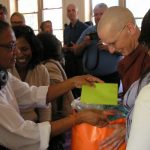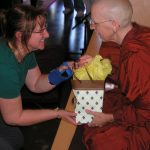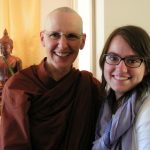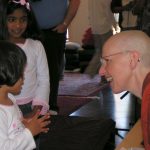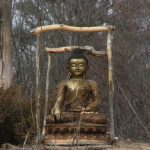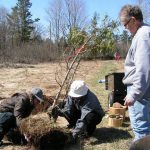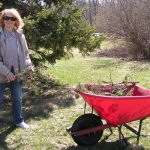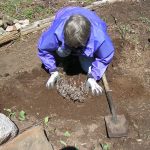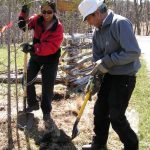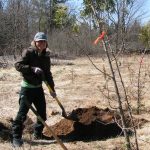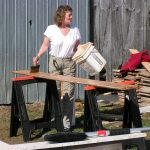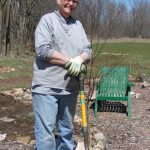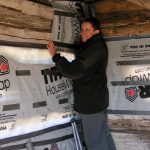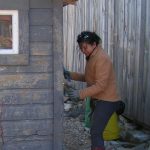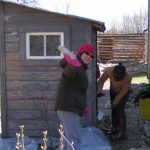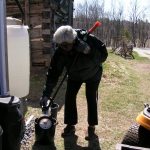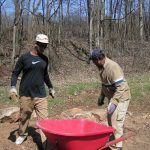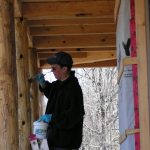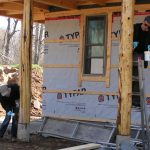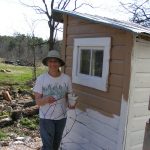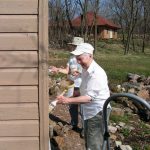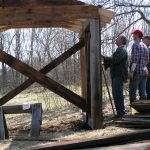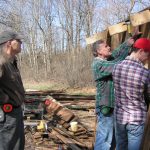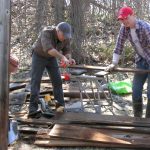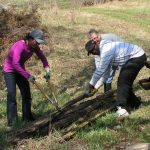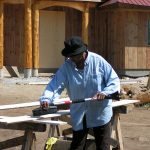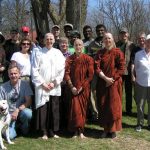Buddhist Women on a Path of Spiritual Awakening
Unexpected Blessings
After the solitude of our winter retreat and the return of bright spring days, we decided to follow the ancient Buddhist practice of walking for alms to receive spontaneous offerings of food from the community. On Saturday mornings, we have been going pindapat in the Perth Farmers’ Market. We stand between the colourful displays of fruits, plants and home-made products where vendors and passers-by exchange friendly greetings. Time and again, our alms bowls have been overflowing with generosity – a sign of the warm reception and interest people express in our way of life and local presence.
These last few weeks have also been a time of receiving new visitors to the Hermitage, notably Ayya Anandabodhi, co-founder of Aloka Vihara in California. Not only is she the first bhikkhuni we have hosted for an extended visit, but we also share more than 20 years of spiritual friendship as nuns. It was rich and meaningful for our community to have her with us and to hear her teach the Dhamma.
We also welcomed visits from several women interested in monastic training. One of them, Denise Morrison of Pennsylvania, presented us with a special gift – a portrait she painted of Arahant Mahapajapati Gotami, the Buddha’s aunt and surrogate mother. This life-like portrayal of our first elder bhikkhuni and ancestral mother is now framed and mounted in our vestibule.
One of our guests from the UK took a spiritual name, Acala (the Pali word for ‘unwavering’), and requested anagarika ordination – living as a homeless one. Her wish to formally receive the eight precepts, wear the white robes and have her head shaved by her 50th birthday will be fulfilled on Saturday, July 5, 2014, in the meditation hall at Sati Saraniya Hermitage.
Acala’s devotion to the teachings of the Buddha stirs us to reaffirm our own aspiration for awakening. We remember how rare and precious it is to live dependent on the kindness of others and to commit ourselves to truth, harmlessness, greater wisdom and compassion. When we reflect in this way, every day for us is filled with blessings. These act like a scaffold that sustains us through the many spiritual trials and hurdles that must be overcome. In turn, what we receive, we give back.
First Things First
Just as a deep lake is clear and still, even so, on hearing the teachings and realising them, the wise become exceedingly peaceful. Dhammapada 82
Every year has been auspicious for our community and 2013 was no exception. We will remember it as the year the Temple was completed, rising in the footprints of four ancient barns that stood sentinel for a century at the top of our driveway. And we remember the many inaugural events we hosted inside the meditation hall – a first day of gratitude to parents with the Tisarana Sangha, a first ordination ceremony, and a first residential retreat on the theme of ‘Death and Dying’.
We also remember the joy of our first mornings of pindapat along the rural lanes of Lanark County. Following the spirit of the Buddha going for alms in village India more than two and a half millenia ago, we walked mindfully in silence with our alms bowls to the homes of dear devotees to receive a meal offering and chant blessings.
During the last five months, the palpable stillness and beauty inside the meditation hall created a welcome haven for many overnight guests, stewards and local friends who joined us for evening and weekend practice sessions. For the first time, this year it will become sanctuary for our three month winter retreat.
By taking this time to stop and devote ourselves to meditation, we practise balancing the pace and demands of our commitments. Instead of focusing outwardly, we give ourselves to the vital work of looking within. Instead of singling out the ‘firsts’ of our past year, or of our life, and remembering them as special, we see and investigate our experience moment by moment.
We discover that every breath is its own ‘first’, a new beginning in which awareness grows clear and deeper truths are revealed. These are the seeds of peace and wisdom that stopping and studying our own hearts can foster.
May each of us remember to stop – no matter how compelling or important our activities, or how much enjoyment they bring. Devotion to the higher mind will yield a greater happiness, a deeper peace, and a viable refuge from the world.
May we all strive to purify our hearts and bring forth more loving-kindness and compassion in this world.
Aspiring to Awaken
On the full moon day of September nearly 2600 years ago, Mahapajapati Gotami, the Buddha’s aunt and foster mother, became the first bhikkhuni to receive ordination in the Buddha’s dispensation and, later, an arahant in her lifetime. This year we honoured her with a pabbajja ceremony at Sati Saraniya Hermitage. One hundred Dhamma friends gathered to witness Anagarikā Ahiṃsā receive samaneri ordination, ‘going forth from home to homelessness’ as a 10-precept Theravada novice nun.
Ahiṃsā means ‘one who brings no harm to anyone’. A native of Vancouver, her endurance, gentleness and compassion during her training, which coincided with major temple construction works at the Hermitage, have endeared her to everyone in our community.
It was groundbreaking for our community, being the first such ritual to be held in the new Temple and in the presence of the Ubhato Sangha or Fourfold Assembly as established by the Buddha, namely: monks, nuns, laymen and laywomen.
Attending the ceremony was Sister Ahiṃsā’s 24 year old daughter, Allison, who travelled from Vancouver especially to witness her mother’s momentous step of deepening her devotion and commitment to the Buddha’s teachings.
How tender the moment when Samaneri Ahiṃsā emerged in her new rust-coloured robes and paused in front of Allison to receive her alms bowl, marking her complete dependence on alms and the kindness of others. Once Allison placed the bowl strap around her mother’s shoulders, Samaneri Ahiṃsā ascended the altar to recite her vows.
For all who sat in the temple, the impact of this rare and moving act of spiritual commitment and renunciation was palpable.
Seeking our own liberation from suffering has the hidden effect of widening the path to awakening for all beings. It is a sign of what is possible, regardless of the trials and storms we must face in life, a reminder of our potential to tap a reservoir of inner resilience, strength and a beauty of heart that can bring forth great blessings.
Dying to be Free
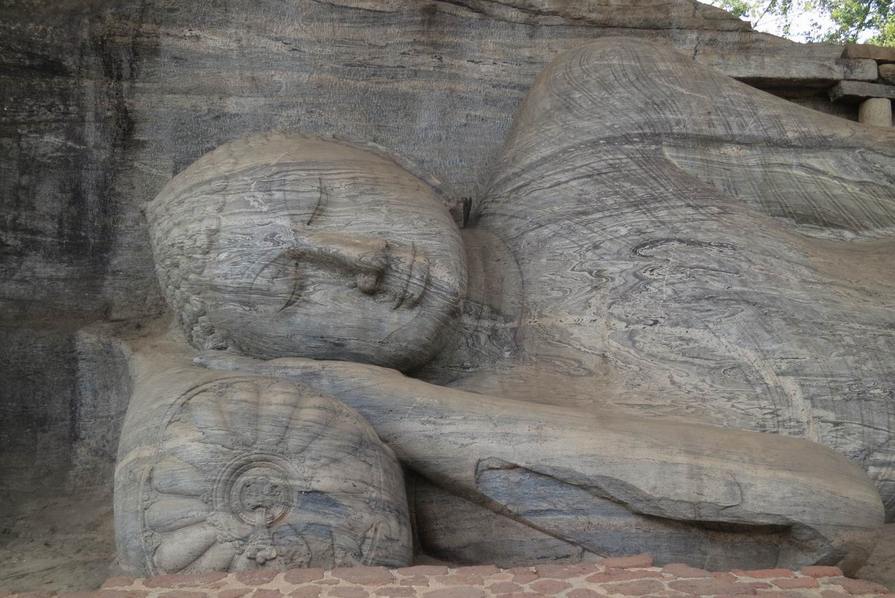 Sati Saraniya Hermitage will host a 3-day “Dying to be Free” meditation retreat (residential and non-residential) on the Remembrance Day Weekend: 6 pm, Friday, Nov. 8 – midday (after the meal) Monday, Nov. 11.
Sati Saraniya Hermitage will host a 3-day “Dying to be Free” meditation retreat (residential and non-residential) on the Remembrance Day Weekend: 6 pm, Friday, Nov. 8 – midday (after the meal) Monday, Nov. 11.
The traditional format of keeping eight precepts and noble silence with periods of sitting/walking meditation in the Temple hall and vestibule areas will be followed. We will also include dedications and remembrance of loved ones, morning and evening chanting, guided death meditation, and Dhamma reflections on dying, freedom from fear and bringing forth joy.
Meals will be simple breakfast (bread/porridge and a hot drink) and potluck dana for 3 days. Tea/coffee and ‘allowables’ in the afternoon. Please bring a dish and/or groceries to share, toilet paper, warm clothes, towel and bedding/sleeping bag. We have a few spare blankets and a good supply of meditation mats and cushions but you are welcome to bring your own.
We have 16 registered for the retreat and residential attendance is now full. Our local Perth community members are warmly welcomed to attend and return home at the end of each day.
Much appreciation and anumodana.
Ajahn Dtun Visits Sati Saraniya Hermitage
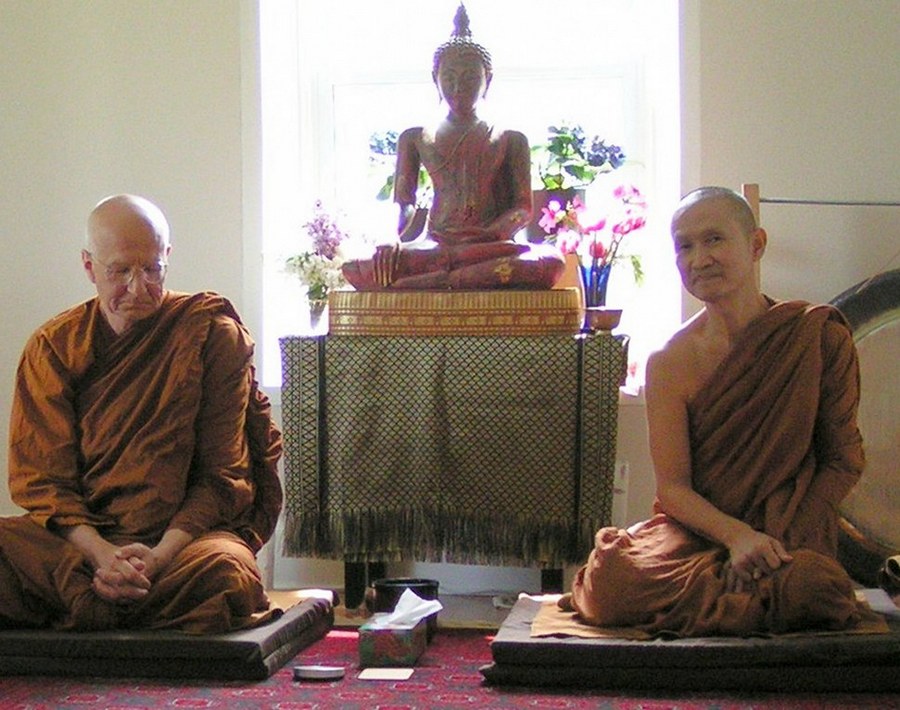
This week of Vesakha puja, the full moon of May, we were graced by the presence of one of Thailand’s most venerated meditation masters and disciples of Ajahn Chah, Venerable Ajahn Dtun (Thirachitto).
Born in Ayutthaya, Thailand in 1955, by his teen years, Ajahn Dtun already felt inclined towards monastic life. In 1978, after receiving a bachelor’s degree in economics, he was accepted to a Master’s program at the University of Colorado. He had thought to further his studies and look after his father until he could ordain as a monk. But one evening, while reading a book on the Dhamma, he came across the last words of the Buddha, “Monks, all things that arise will pass away. Strive on without heedlessness.”
He was so moved that within two months, he arrived at Wat Nong Pah Pong to ordain with the Venerable Ajahn Chah. He resolved “to ordain for life and be in the forest or in caves like the Buddha”. With his great skill and determination, Ajahn Dtun soon became an accomplished meditator. He travelled to other branch monasteries and stayed with Ajahn Piak and Ajahn Anan at Wat Fah Krahm for 4 years. Then he helped Ajahn Anan establish Wat Marb Jan on a forested mountain and after five years, in 1990, he went into solitude in the forest of Boonyawat in Chonburi province to further his practice.
After two and a half years of seclusion, 100 acres of land was offered to establish Wat Boonyawat under Ajahn Dtun’s leadership. In 2008, he was diagnosed with stage 3 colon cancer and in the following year of treatment, he underwent 4 major surgeries and 12 courses of chemotherapy. Devotees eager to do good works to prolong his life donated more land for a stupa to be built.
Ajahn Dtun is now in good health and residing at Wat Boonyawat. The monastery encompasses 200 acres of forest and many flock there to listen to his teachings. There are regularly 40-50 monks that live and practise under Ajahn Dtun’s guidance and he also travels to visit monasteries in Western countries. During his stay at Tisarana Monastery, he kindly accepted our invitation to visit Sati Saraniya Hermitage accompanied by Ajahn Viradhammo and Ajahn Tejapañño, his translator from Australia.
We are deeply inspired and blessed by this remarkable meeting with Ajahn Dtun as we near completion of the temple building. May we follow his heroic example and heed the Blessed One’s exhortation to strive diligently on the Path of awakening.
Blessing Each Moment
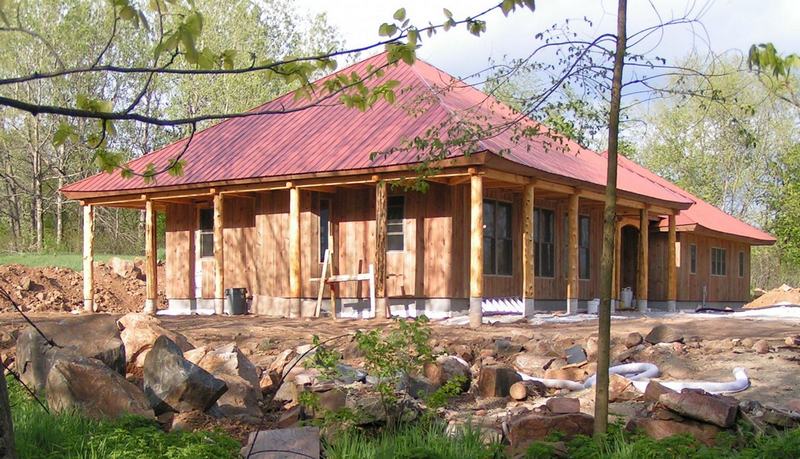 Over 25 years ago, I took the 10-precept nun’s ordination in Myanmar; and five years ago, I returned to Canada to establish Sati Saraniya Hermitage. Recently, as we emerged from our annual Winter retreat to see the snow melting and Canada geese flocking home, I reflected on the impermanence of all things and especially how unwavering refuge in the Dhamma has been my true home.
Over 25 years ago, I took the 10-precept nun’s ordination in Myanmar; and five years ago, I returned to Canada to establish Sati Saraniya Hermitage. Recently, as we emerged from our annual Winter retreat to see the snow melting and Canada geese flocking home, I reflected on the impermanence of all things and especially how unwavering refuge in the Dhamma has been my true home.
During our time of seclusion, the Temple builders respectfully and quietly continued working. They framed interior walls, roughed in the electrical wiring, plumbing and heating, and sprayed foam insulation in the walls. In the last few weeks of Spring, they created the beautiful tongue-and-groove wood ceiling of the meditation hall, installed the windows and mounted the exterior cladding in preparation for a day of honouring our parents and teachers on the Path which we hosted together with the monks from Tisarana Buddhist Monastery.
In the transitions we make from times of quiet such as retreat to the business of daily activities, we have to attend to many tasks and responsibilities. These may appear to be obstacles to our practice. In fact, they are opportunities for us to continue developing mindfulness in all four postures while honing our Dhamma skills with greater wisdom, compassion and equanimity.
While we work, rather than wishing we could just stay within the special conditions of retreat that suit our peace of mind, we try to sustain our intention not just to get a job done but to develop the four sublime abidings of the mind, brahma vihāras of loving-kindness, compassion, altruistic joy and equanimity. This means continuously clearing the ground of our mind’s debris and seeing the unwholesome inclinations and thoughts that are to be abandoned.
In their place, we cultivate good will and kind intentions which arise from empathy for others in their joys and struggles instead of harbouring negative and critical mind states such as competitiveness, resentment or disdain. Hardest of all, we turn the mind to equanimity, to abide peacefully with conditions just as they are, not from resignation or passivity but from understanding the ways of the world and refraining from giving in to self-centred desire or ill-will.
The resilience and peace that equanimity bestows can be learned during these passages from states of quiet to activity. Not holding onto either extreme, we practice the Buddha’s ‘Middle Way’. We walk right down the middle – empty of the self that grasps for anything at all. We do this for one moment and another moment, patiently practising what is hard for humans to do. At first we crawl along, dragged down by habitual thoughts – until we learn to get up and walk. It is a way of walking that is contented and serene, with loving-kindness and joy. And as our wings to awakening grow, at last, we learn to soar.
May your Dhamma practice flourish and sustain you in peace of heart and joyful well-being.
Medhānandī Bhikkhunī
Working Wonders
This Spring we held two consecutive Mindful Work Bee weekends attended by two groups of almost 20 volunteers at the Hermitage. Everyone dedicated their time and skills so generously, bringing abundant offerings of food as well as joy, enthusiasm and a variety of tools to work with. The projects included painting, gardening, refurbishing a log cabin, building a storage shed, preserving the siding of the new temple, clearing an old burn pile, putting up a fence along the main driveway, emptying an old barn in preparation for its dismantling, protecting the temple cedar posts with hemp oil and tidying the construction site.
We are very grateful for all that was accomplished in such a spirit of friendship, appreciation, mindfulness and heartfelt community. Here are a few photo highlights.
May these great blessings be shared in all directions.
Winter Retreat
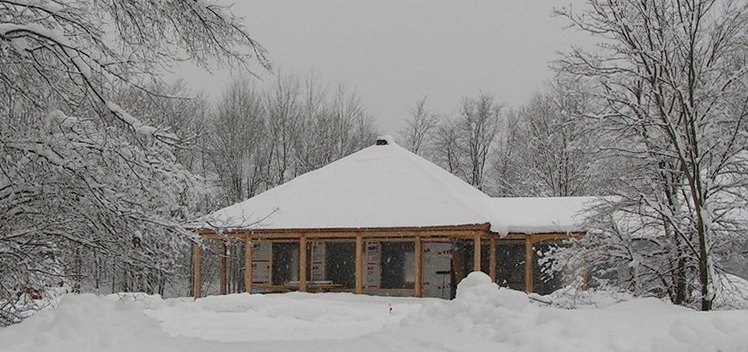 Winter gives us the rare opportunity for silent reflection in the seclusion of the monastery. It is a time to put down our projects and devote ourselves to meditation practice, the core of monastic life. By calming and stilling the mind, we can develop greater clarity and wisdom, while living a life of restraint and harmlessness helps us to bring forth more patience, tolerance, kindness and compassion. These are the qualities we all need to keep sowing the seeds of our own freedom.
Winter gives us the rare opportunity for silent reflection in the seclusion of the monastery. It is a time to put down our projects and devote ourselves to meditation practice, the core of monastic life. By calming and stilling the mind, we can develop greater clarity and wisdom, while living a life of restraint and harmlessness helps us to bring forth more patience, tolerance, kindness and compassion. These are the qualities we all need to keep sowing the seeds of our own freedom.
During this three month retreat, the builders will carry on constructing the temple to complete it before summer. We have scheduled work days and teaching events on our calendar for the Spring of 2013.
We hope that our practice will be a source of blessing even in some small way, a reminder to strive for greater peace where peace begins – within our own hearts.
Winter’s Advent 2012
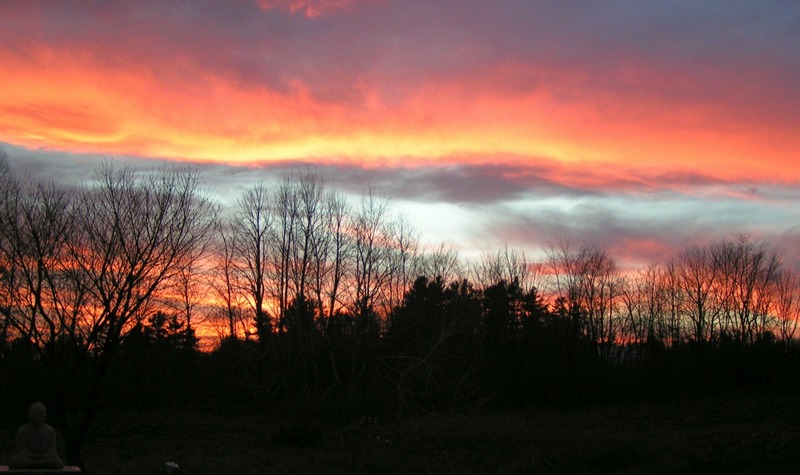 As winter approaches, we pause, like the blue-gray forms of forest and field that silently witness the season’s change. We contemplate the changes we have seen just in this last year; the passing away of good friends, beings born and to be born, friends who have graduated and found work, and others newly retired from long years of working.
As winter approaches, we pause, like the blue-gray forms of forest and field that silently witness the season’s change. We contemplate the changes we have seen just in this last year; the passing away of good friends, beings born and to be born, friends who have graduated and found work, and others newly retired from long years of working.
Here at the Hermitage, many special visitors have come to share blessings with us. We have seen Anagarikā Ahimsā (Robyn Church) grow in her training as a postulant through her faith, commitment, perseverance, service and good-will. When Bhante Gunaratana blessed us with a visit in May, he said to her, “Next time I come, I hope you will be ordained.”
An ordination, like a wedding, lasts a short time, but the fulfillment of our vows depends to a large degree on the quality of our endeavour. In what do we really take refuge? And can we stay the course?
For all of us, that’s hard to do especially when things are uncertain or break down or when the dark days of winter draw in. At these times, faith and determination can brace us to keep sowing the seeds of our own freedom. We may not see immediate results, but at least we can bless this hour, this day, the very breath or step that we are taking right now.
If we can see life with Right View – knowing how things truly are, and act from Right Intention – to develop skilful qualities of mind, we can meet change with greater peace and wisdom in our hearts.
So it has been with building the temple. What began as a mere sketch on a piece of paper is now a temple in progress standing outlined against the sky. We have been able to reach this stage of the project due to the faith, generosity and encouragement we receive from all of you, near and far, coming forth to support the work we are doing.
Through the convergence of these collective wholesome intentions, we are reminded that this is more than just a temple for nuns. We are creating a spiritual resource and sanctuary for generations to come.
At the cusp of a new year, it is time for our annual 3-month retreat when we devote ourselves to meditation. While the builders carry on constructing the temple, we hope that our practice will be a source of blessing even in some small way to each of you. May we all strive to purify our hearts and bring forth greater loving-kindness and compassion in this world now, as we begin a New Year, and for all the days of our lives.
A Temple in Progress
[slideshow]Thanks to the faith, generosity and encouragement of so many, our temple building now stands gently outlined against the sky, its roof whitened by a blanket of snow. While our carpenters, who all live locally, continue the construction in the cold of winter, we observe with joy the care and dedication that they bring to this project.
With so many kind and wholesome intentions reaching us from near and far, we are reminded that this is more than just a temple for nuns. The new Dhamma Hall will is a spiritual sanctuary for this and generations to come.
The above photos show the building’s evolution during its first months of construction, as well as gatherings with small groups of friends to watch the cement poured for the footings and foundations. At these auspicious times, we chanted verses of blessing and placed sacred objects and memories of loved ones in the temple foundations.
Twenty-two beautiful cedar posts surround the walking meditation porch and help support the roof of the Dhamma hall. They were discovered standing in the forest of a friend near our builder’s home just half an hour from the Hermitage. Having died during the ice storm 14 years ago, the trees had lost their canopy but their trunks were still in tact. Our builders carefully harvested them, brought them to the site and cleaned off their outer bark before resurrecting them as part of the temple.
The original design was adapted from a 12th century Japanese Buddhist temple and modified to comply with Canadian climate conditions. With the building’s dimensions totaling just over 2100 square feet, it is designed to be energy efficient using passive solar and requiring minimal ongoing maintenance.
It includes a 784 square foot Dhamma hall that will seat about 70 for meditation, Dhamma teachings, blessings, ordination ceremonies, and alms-giving events. There will also be vestibule for coats and shoes as well as indoor walking meditation in winter, and a utility building with two public washrooms, two offices, a nuns’ work-meeting room, shower and laundry area, and a mechanical room.
The prelude to building this temple was dismantling a 100 x 50 square foot barn, most of which has been saved and will be reused by the team of enthusiastic neighbours who worked together to remove it. You can see how it finally came down, opening the space where the new temple now stands within a circle of welcoming trees.
Though all is uncertain – especially in the world of construction – we hope to host Gratitude to Parents Day on June 23, 2013 with Ajahn Viradhammo and the Sangha of Tisarana Buddhist Monastery in our new temple.
Completing the new Temple shows the culmination of this beautiful project.
